Unit4 Section A (2a-2d) 课件+内嵌音频 (新目标七年级上册 Unit 4 Where's my schoolbag?)
文档属性
| 名称 | Unit4 Section A (2a-2d) 课件+内嵌音频 (新目标七年级上册 Unit 4 Where's my schoolbag?) | 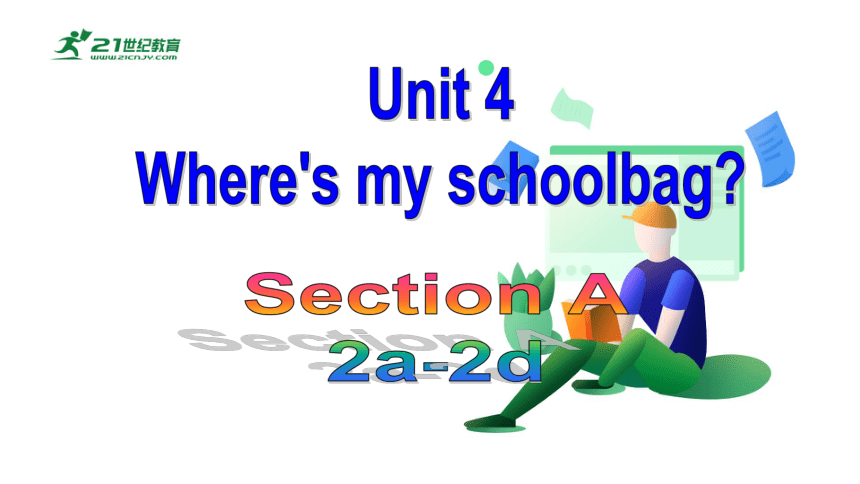 | |
| 格式 | pptx | ||
| 文件大小 | 7.4MB | ||
| 资源类型 | 试卷 | ||
| 版本资源 | 人教新目标(Go for it)版 | ||
| 科目 | 英语 | ||
| 更新时间 | 2023-10-01 20:53:40 | ||
图片预览

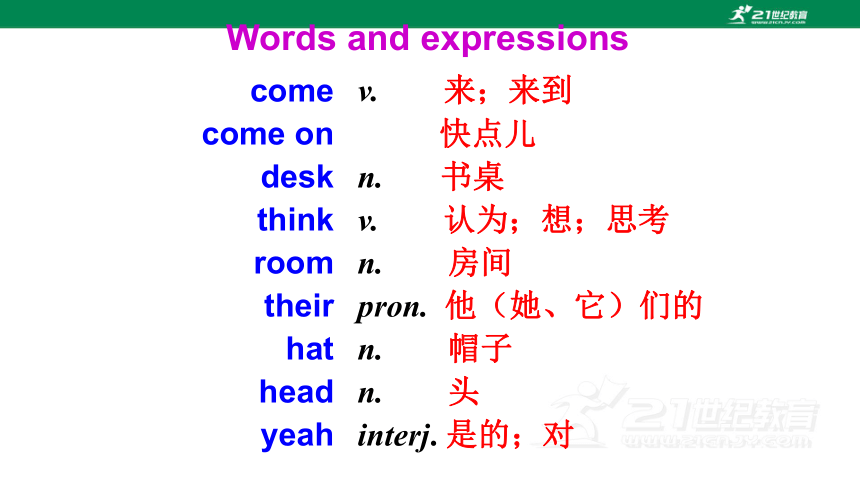
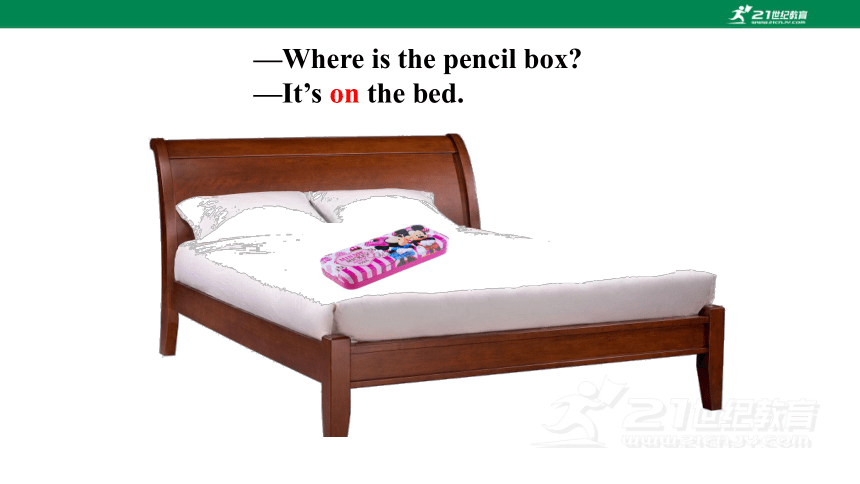
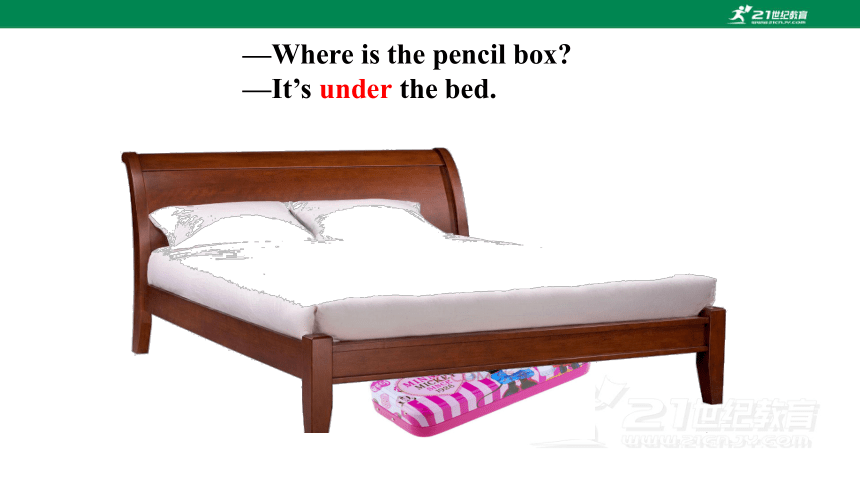
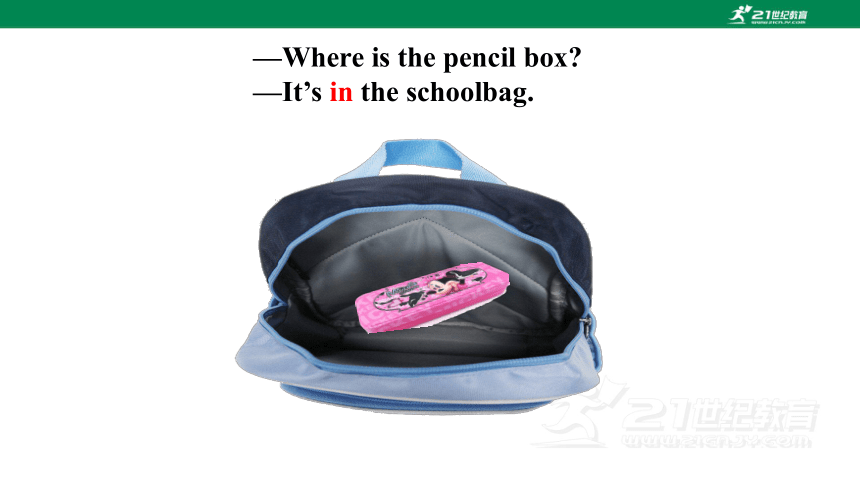
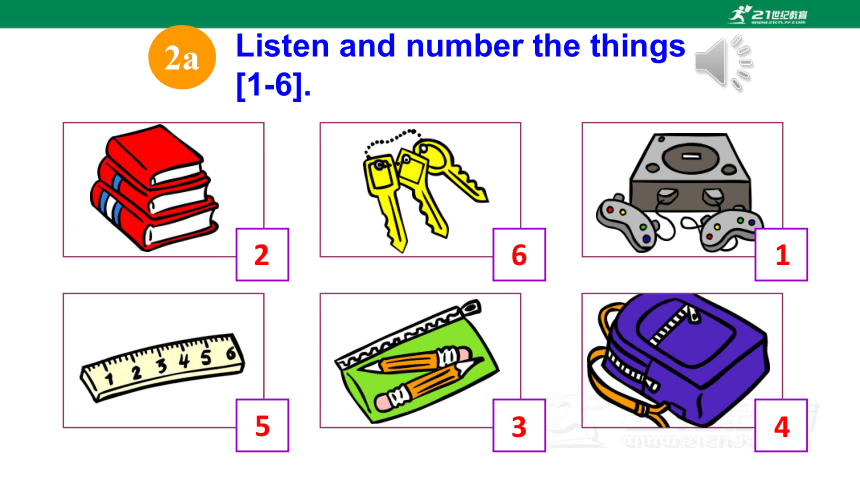
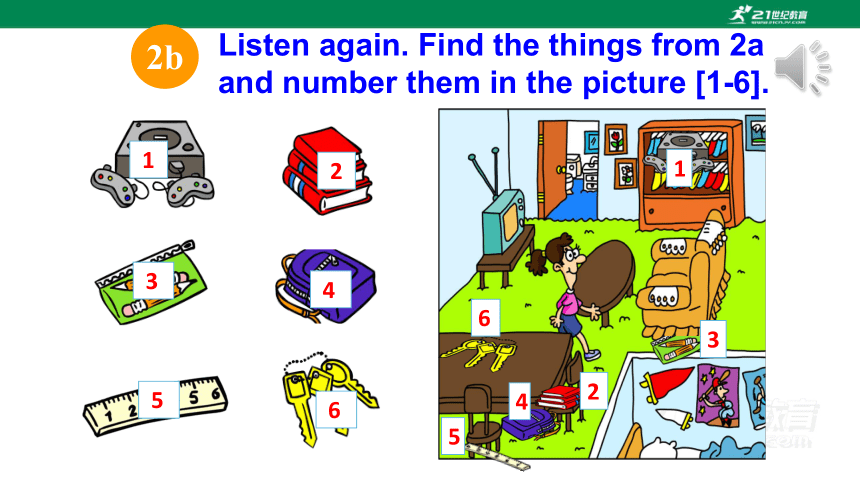
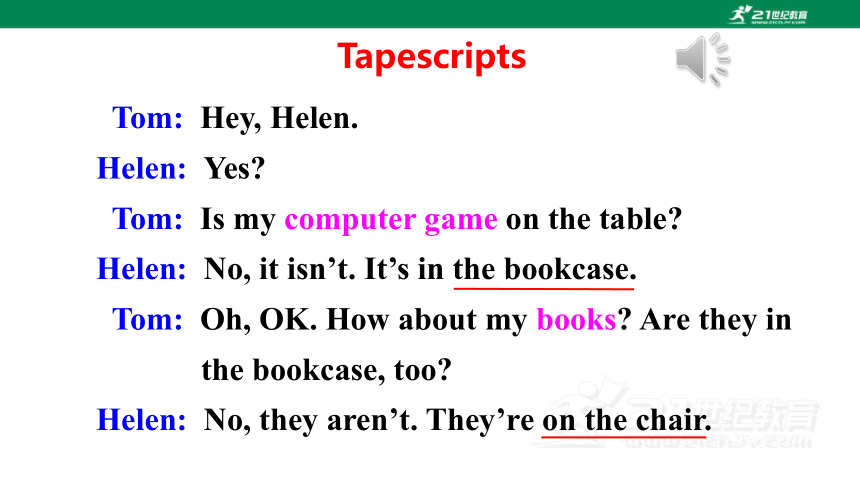
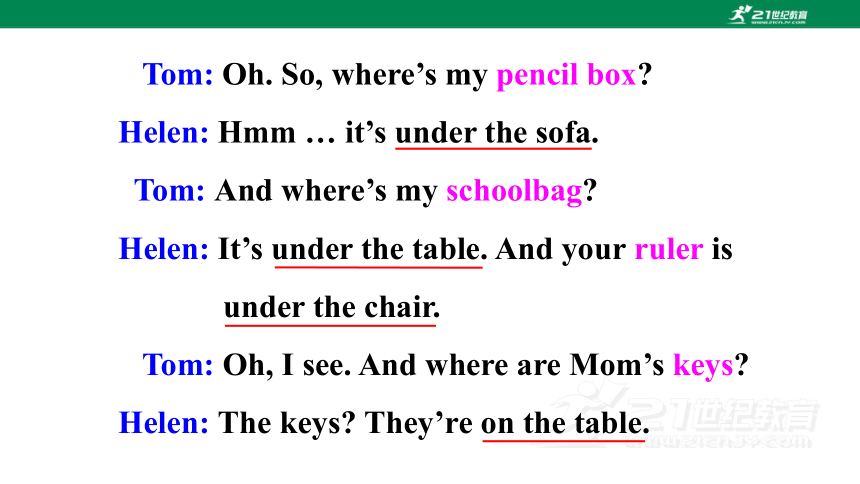
文档简介
(共28张PPT)
Unit 4
Where's my schoolbag
Section A
2a-2d
Words and expressions
come
come on
desk
think
room
their
hat
head
yeah
v. 来;来到
快点儿
n. 书桌
v. 认为;想;思考
n. 房间
pron. 他(她、它)们的
n. 帽子
n. 头
interj. 是的;对
—Where is the pencil box
—It’s on the bed.
—Where is the pencil box
—It’s under the bed.
—Where is the pencil box
—It’s in the schoolbag.
2a
Listen and number the things [1-6].
1
2
6
5
3
4
2b
Listen again. Find the things from 2a and number them in the picture [1-6].
1
2
3
4
5
1
2
3
5
4
6
6
Tom: Hey, Helen.
Helen: Yes
Tom: Is my computer game on the table
Helen: No, it isn’t. It’s in the bookcase.
Tom: Oh, OK. How about my books Are they in
the bookcase, too
Helen: No, they aren’t. They’re on the chair.
Tapescripts
Tom: Oh. So, where’s my pencil box
Helen: Hmm … it’s under the sofa.
Tom: And where’s my schoolbag
Helen: It’s under the table. And your ruler is
under the chair.
Tom: Oh, I see. And where are Mom’s keys
Helen: The keys They’re on the table.
2c
Ask and answer questions about the things in the picture in 2b.
Are the books on the sofa
No, __________________.
They’re ______________.
they aren’t
on the chair
Is the computer game on the table
No, ____________.
It’s ________________.
it isn’t
on the bookcase
Is _____________ under the sofa
Yes, __________.
the pencil case
it is
Is the schoolbag
______________
Yes, it is.
under the table
Are the keys ____________
No, ____________________.
They’re ________________.
on the floor
they aren’t
on the table
—Are the keys on the sofa 钥匙在沙发上吗?
—No, they aren’t. 不,它们不在(沙发上)。
(1) they“他(她,它)们”,是主格人称代词,
在句中作主语,指代前面提到的复数的人或
物,其谓语若用 be动词时,必须用are。
如:They are my good friends.
Language points
(2) 在回答用these/those作主语的一般疑问句时,答句的主语要用人称代词 they 来代替指示代词these或those。
—Are these/those chairs …
—Yes, they are. /No, they aren’t.
2d
Role-play the conversation.
Mom: Come on, Jack!
Jack: Oh, no! Where’s my bag
Mom: Hmm … is it on your desk
Jack: No. And it’s not under the chair.
Mom: Oh! It’s on the sofa.
Jack: Thank you, Mom. Err … where’s the map
Mom: I think it’s in your grandparents’ room.
Jack: Yes, it’s on their bed! And my hat
Mom: It’s on your head!
Jack: Oh, yeah! Haha!
Read the conversation again, and answer the following questions.
1. Where is Jack’s bag
2. Where is the map
3. Where is Jack’s hat
It is on the sofa.
It is on Jack’s grandparents’ bed.
It is on his head.
Close your book and
role-play the conversation.
Mom: Come on, Jack!
Jack: Oh, no! _________________
Mom: Hmm … is it on your desk
Jack: ________________________________.
Mom: Oh! It’s on the sofa.
Jack: Thank you, Mom. Err … where’s the map
Mom: _______________________________________.
Jack: Yes, it’s on their bed! And my hat
Mom: ______________________!
Jack: Oh, yeah! Haha!
Where’s my bag
No. And it’s not under the chair
I think it’s in your grandparents’ room
It’s on your head
Language points
1.come on快点儿
(1) 用来催促别人快走(做),意为“快点儿”。
(2) 用来表示请求、鼓励、劝说等,意为“来吧;行”。
(3) 用于体育竞赛等场合鼓励队员,意为“加油”。
(4) 用于挑战或激怒对方,意为“来吧;好吧;试试”。
(5) 用于招呼别人,意为“来,过来”。
2. think v. 认为; 想; 思考
(1) think动词,意为“认为; 想; 思考”。I think“我认为”, 表述自己的主观想法或看法, 后边常跟that引导
的从句作宾语, 即宾语从句,口语中that常常被省略。
(2) 当主语是第一人称 (I, we) , think表示“认为”, 其后接宾语从句时,若宾语从句表示否定意义, 在形式
上应该否定前面的主句, 这种现象叫否定转移。
【活学活用】
① 我认为他是你的朋友。
he is your friend.
② I think Tom is her cousin. (改为否定句)
_________________________________
I think
I don’t think Tom is her cousin.
Ⅰ. 单项选择。
1. — are the bags
—They are on the floor.
A. Where B. How C. What D. Who
2. —Is the key on the sofa — .
A. No, I’m not B. Yes, it is
C. No, it’s under it D. Yes, it isn’t
Exercise
3. Sally’s computer game is the bookcase.
A. in B. under C. at D. for
4. —Are those Bill’s keys —No, aren’t.
A. it B. they C. these D. those
5. —Where is the map —It’s your room.
A. on; parent’s B. in; parent’s
C. in; parents’ D. on; parents’
Ⅱ. 完成句子。
1. 他的书包在沙发上。 His schoolbag ___ ___ ____ _____.
2. 我的棒球在椅子下面。
My baseballs .
3. 你的钥匙在书包里吗
your keys
4. 你的父母在哪里 your parents
5. 我的手表在床底下。 My watch .
is on the sofa
are under the chair
Are in the schoolbag
Where are
is under the bed
summary
1.-Are the keys on the ...
-No, they aren't. They're on the ...
2.-Where's the ...
-I think it's ...
1.仿造2d对话,使用2a物品编对话。
2.完成本课时相关练习。
The end!
Unit 4
Where's my schoolbag
Section A
2a-2d
Words and expressions
come
come on
desk
think
room
their
hat
head
yeah
v. 来;来到
快点儿
n. 书桌
v. 认为;想;思考
n. 房间
pron. 他(她、它)们的
n. 帽子
n. 头
interj. 是的;对
—Where is the pencil box
—It’s on the bed.
—Where is the pencil box
—It’s under the bed.
—Where is the pencil box
—It’s in the schoolbag.
2a
Listen and number the things [1-6].
1
2
6
5
3
4
2b
Listen again. Find the things from 2a and number them in the picture [1-6].
1
2
3
4
5
1
2
3
5
4
6
6
Tom: Hey, Helen.
Helen: Yes
Tom: Is my computer game on the table
Helen: No, it isn’t. It’s in the bookcase.
Tom: Oh, OK. How about my books Are they in
the bookcase, too
Helen: No, they aren’t. They’re on the chair.
Tapescripts
Tom: Oh. So, where’s my pencil box
Helen: Hmm … it’s under the sofa.
Tom: And where’s my schoolbag
Helen: It’s under the table. And your ruler is
under the chair.
Tom: Oh, I see. And where are Mom’s keys
Helen: The keys They’re on the table.
2c
Ask and answer questions about the things in the picture in 2b.
Are the books on the sofa
No, __________________.
They’re ______________.
they aren’t
on the chair
Is the computer game on the table
No, ____________.
It’s ________________.
it isn’t
on the bookcase
Is _____________ under the sofa
Yes, __________.
the pencil case
it is
Is the schoolbag
______________
Yes, it is.
under the table
Are the keys ____________
No, ____________________.
They’re ________________.
on the floor
they aren’t
on the table
—Are the keys on the sofa 钥匙在沙发上吗?
—No, they aren’t. 不,它们不在(沙发上)。
(1) they“他(她,它)们”,是主格人称代词,
在句中作主语,指代前面提到的复数的人或
物,其谓语若用 be动词时,必须用are。
如:They are my good friends.
Language points
(2) 在回答用these/those作主语的一般疑问句时,答句的主语要用人称代词 they 来代替指示代词these或those。
—Are these/those chairs …
—Yes, they are. /No, they aren’t.
2d
Role-play the conversation.
Mom: Come on, Jack!
Jack: Oh, no! Where’s my bag
Mom: Hmm … is it on your desk
Jack: No. And it’s not under the chair.
Mom: Oh! It’s on the sofa.
Jack: Thank you, Mom. Err … where’s the map
Mom: I think it’s in your grandparents’ room.
Jack: Yes, it’s on their bed! And my hat
Mom: It’s on your head!
Jack: Oh, yeah! Haha!
Read the conversation again, and answer the following questions.
1. Where is Jack’s bag
2. Where is the map
3. Where is Jack’s hat
It is on the sofa.
It is on Jack’s grandparents’ bed.
It is on his head.
Close your book and
role-play the conversation.
Mom: Come on, Jack!
Jack: Oh, no! _________________
Mom: Hmm … is it on your desk
Jack: ________________________________.
Mom: Oh! It’s on the sofa.
Jack: Thank you, Mom. Err … where’s the map
Mom: _______________________________________.
Jack: Yes, it’s on their bed! And my hat
Mom: ______________________!
Jack: Oh, yeah! Haha!
Where’s my bag
No. And it’s not under the chair
I think it’s in your grandparents’ room
It’s on your head
Language points
1.come on快点儿
(1) 用来催促别人快走(做),意为“快点儿”。
(2) 用来表示请求、鼓励、劝说等,意为“来吧;行”。
(3) 用于体育竞赛等场合鼓励队员,意为“加油”。
(4) 用于挑战或激怒对方,意为“来吧;好吧;试试”。
(5) 用于招呼别人,意为“来,过来”。
2. think v. 认为; 想; 思考
(1) think动词,意为“认为; 想; 思考”。I think“我认为”, 表述自己的主观想法或看法, 后边常跟that引导
的从句作宾语, 即宾语从句,口语中that常常被省略。
(2) 当主语是第一人称 (I, we) , think表示“认为”, 其后接宾语从句时,若宾语从句表示否定意义, 在形式
上应该否定前面的主句, 这种现象叫否定转移。
【活学活用】
① 我认为他是你的朋友。
he is your friend.
② I think Tom is her cousin. (改为否定句)
_________________________________
I think
I don’t think Tom is her cousin.
Ⅰ. 单项选择。
1. — are the bags
—They are on the floor.
A. Where B. How C. What D. Who
2. —Is the key on the sofa — .
A. No, I’m not B. Yes, it is
C. No, it’s under it D. Yes, it isn’t
Exercise
3. Sally’s computer game is the bookcase.
A. in B. under C. at D. for
4. —Are those Bill’s keys —No, aren’t.
A. it B. they C. these D. those
5. —Where is the map —It’s your room.
A. on; parent’s B. in; parent’s
C. in; parents’ D. on; parents’
Ⅱ. 完成句子。
1. 他的书包在沙发上。 His schoolbag ___ ___ ____ _____.
2. 我的棒球在椅子下面。
My baseballs .
3. 你的钥匙在书包里吗
your keys
4. 你的父母在哪里 your parents
5. 我的手表在床底下。 My watch .
is on the sofa
are under the chair
Are in the schoolbag
Where are
is under the bed
summary
1.-Are the keys on the ...
-No, they aren't. They're on the ...
2.-Where's the ...
-I think it's ...
1.仿造2d对话,使用2a物品编对话。
2.完成本课时相关练习。
The end!
同课章节目录
- starters 预备篇(2012秋审查)
- Unit 1 Good morning !
- Unit 2 What’s this in English?
- Unit 3 What color is it ?
- Unit 1 My name's Gina.
- Section A
- Section B
- Unit 2 This is my sister.
- Section A
- Section B
- Unit 3 Is this your pencil?
- Section A
- Section B
- Unit 4 Where's my schoolbag?
- Section A
- Section B
- Unit 5 Do you have a soccer ball?
- Section A
- Section B
- Unit 6 Do you like bananas?
- Section A
- Section B
- Unit 7 How much are these socks?
- Section A
- Section B
- Unit 8 When is your birthday?
- Section A
- Section B
- Unit 9 My favorite subject is science.
- Section A
- Section B
